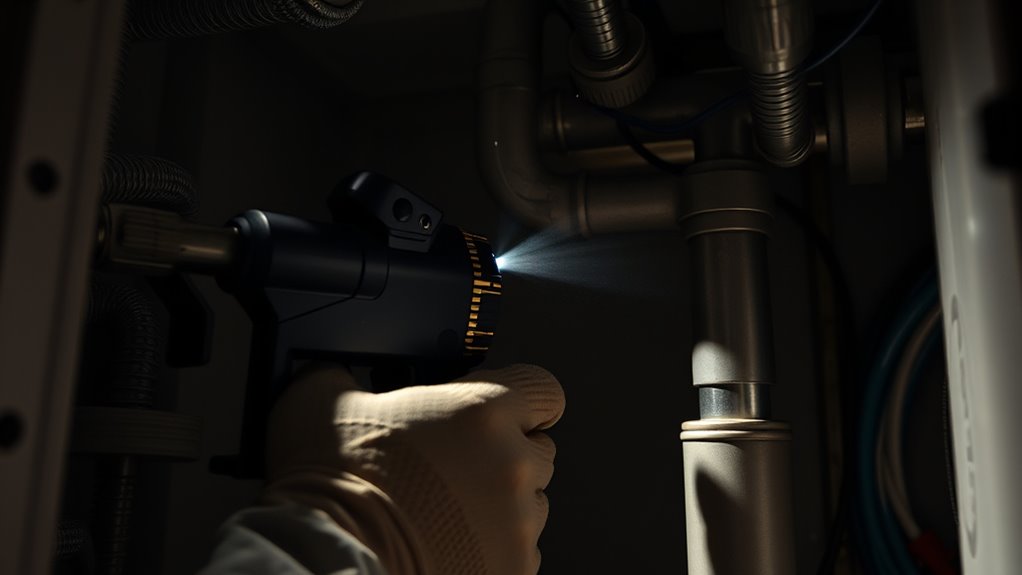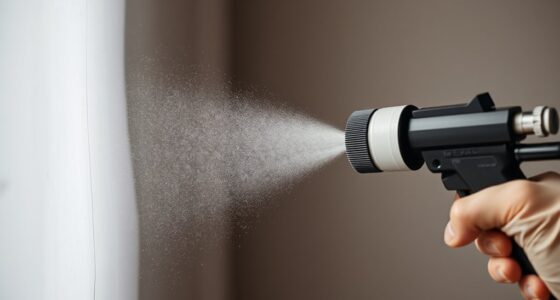When spraying in tight spaces, prioritize ventilation by opening windows or using portable fans to disperse fumes and improve airflow. Use smaller spray patterns and flexible tools like angled tips or extension hoses to navigate confined areas. Keep your workspace clean, wear proper PPE, and follow manufacturer instructions for consistent coverage. Patience and careful technique are key to avoiding drips and uneven results. Exploring these strategies further can help you master spraying safely and effectively in challenging spots.
Key Takeaways
- Use smaller spray tips and flexible extension hoses for better reach in confined areas.
- Ensure proper workspace ventilation with open windows, doors, or portable fans to disperse fumes.
- Maintain consistent spray distance and controlled patterns to achieve even coverage and prevent drips.
- Wear appropriate PPE, including respirators and goggles, to ensure safety from fumes and overspray.
- Prepare the workspace by clearing clutter and sealing vents to improve safety and spray accuracy.

Spraying in tight spaces can be challenging, but with the right techniques and tools, you can achieve smooth, even results. The confined environment limits movement and airflow, which makes controlling overspray and guaranteeing proper coverage more difficult. To tackle this, you first need to focus on effective ventilation techniques. Proper ventilation is essential to disperse fumes and dust, protect your respiratory health, and improve visibility. Open windows and doors whenever possible, and use portable fans to direct airflow out of the workspace. If the space has limited ventilation, consider using a respirator mask rated for fumes and particles. This not only safeguards your health but also assures you can work longer without discomfort or risk.
Effective ventilation is key to safe, smooth spraying in confined spaces.
When working in tight quarters, it’s vital to plan your spraying approach carefully. Use smaller, more controlled spray patterns and keep your distance consistent to prevent drips or uneven coverage. Maintain a steady hand, and avoid rushing the job. Keep your tools clean and well-maintained; clogged nozzles or inconsistent spray patterns can make the process more difficult and increase the risk of accidents or messes. To reach into corners and tight spots, use specialized tools like angled spray tips or flexible extension hoses. These tools give you better access without compromising control, especially when you’re working in confined areas. Additionally, understanding the importance of proper ventilation can significantly improve the safety and quality of your work environment.
Safety precautions should always be at the forefront of your mind. Before starting, clear the workspace of unnecessary clutter to prevent accidental spills or injuries. Wear appropriate personal protective equipment, including gloves, goggles, and a respirator mask, especially in poorly ventilated areas. Keep a fire extinguisher nearby if you’re working with flammable materials, and avoid smoking or creating sparks during the spraying process. Be mindful of your surroundings—make sure there are no open flames or heat sources nearby that could ignite fumes.
Additionally, follow manufacturer instructions for the products you’re using. This includes recommended spray distances, drying times, and cleanup procedures. Properly sealing off vents and openings not only improves the quality of your work but also prevents fumes from spreading to other areas, which is critical for your safety and the safety of others. Remember, patience and preparation are key. Take your time to set up your workspace correctly, and don’t rush through the process. With proper ventilation techniques and safety precautions, you’ll find spraying in tight spaces more manageable and, ultimately, more successful.
Frequently Asked Questions
What Safety Precautions Are Necessary When Spraying in Confined Areas?
When spraying in confined spaces, you need to prioritize safety by wearing protective gear like masks, goggles, and gloves to prevent inhalation and skin contact. Make certain proper ventilation strategies are in place to disperse fumes and reduce buildup of hazardous vapors. Always check for adequate airflow, and consider using exhaust fans or opening vents to maintain a safe environment. Follow these precautions to protect yourself and ensure a safe spraying process.
How Do I Prevent Overspray in Tight Spaces?
To prevent overspray in tight spaces, focus on precision application by using small, controlled sprays and steady your hand. Employ masking techniques to cover areas you don’t want to paint, ensuring cleaner results. Keep the spray tip close to the surface and move slowly to control the flow. These methods help you minimize overspray, achieve a professional finish, and work efficiently within confined areas.
Which Types of Sprayers Are Best for Narrow or Hard-To-Reach Spots?
Did you know that 75% of painters prefer handheld sprayers for tight spots? For narrow or hard-to-reach areas, you should use sprayers equipped with precision nozzles. These sprayers give you better control and minimize overspray. Handheld sprayers are lightweight and easy to maneuver, making them ideal for confined spaces. Choose models with adjustable nozzles to guarantee you can target specific spots accurately and finish your job efficiently.
How Can I Improve Visibility When Spraying in Small Areas?
To improve visibility when spraying in small areas, you should enhance your lighting and guarantee your tools are easily accessible. Use a small, focused flashlight or LED headlamp to illuminate tight spots clearly. Keep your tools organized and within reach to avoid unnecessary movements. This combination allows you to see better, work more efficiently, and avoid missed spots or mistakes in confined spaces.
What Maintenance Is Required for Tools Used in Tight Spaces?
You should regularly clean your tools after each use to prevent buildup and guarantee smooth operation. Follow the manufacturer’s guidelines for tool cleaning, using appropriate solvents or brushes. Additionally, keep to a strict lubrication schedule to prevent rust and maintain ideal performance. Proper maintenance not only extends the lifespan of your tools but also guarantees they work efficiently in tight spaces, helping you complete your spraying tasks effectively and safely.
Conclusion
When working in tight spaces, you’ll find that patience and the right tools make all the difference. With careful planning and gentle handling, you can navigate even the most tricky spots smoothly. Remember, a delicate touch often yields the best results, turning a challenging task into a rewarding one. Embrace the subtle art of precision, and you’ll master spraying in tight spaces with confidence and finesse—proving that sometimes, less is truly more.










